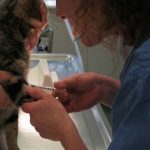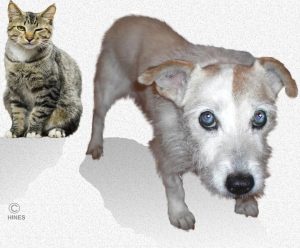Memory Loss In Your Dog & Cat CDS, CCDS, Dementia “Doggie Alzheimer’s”
Ron Hines DVM PhD
 Bile Acids test when due to liver disease?
Bile Acids test when due to liver disease?
What Exactly Is Cognitive Dysfunction Syndrome?
Age takes its toll on the body – ours and our pets. Canine Cognitive Dysfunction Syndrome (CDS or CCDS) is a fancy term for the mental decline of old age. It occurs in cats as well as dogs, so I do not use the term CCDS. In our dogs and cats, it’s the equivalent of Alzheimer’s disease dementia in people. And just like Alzheimer’s disease, brain structure has been lost due to the wear and tear of time. The rate with which it progresses in dogs and cats is variable. That structure cannot – at least in 2018 – be restored. You can only recognize it managed it and deal with it as best you can. I’ll get into some of the things you might try further down in this article. From a psychological viewpoint, in dogs and cats it is the loss of memory and decision-making ability.
The mental decline of old age is currently the subject of a vast amount of research. Through August 2020, 170,866 studies on the subject have been published and indexed by PubMed. None have lead to breakthrough ways for veterinarians or physicians to slow, reverse or prevent this disease
Age related memory loss (=CDS/cognitive dysfunction syndrome) in your dog or cat is not a disease – so it is no more a “syndrome” than is your hair turning gray. It is a normal effect of the aging process, a stage of life that cannot be avoided. Veterinarians and pet owners recognize it more in dogs than in cats because the two species tend to interact with us differently. Whether dogs develop these brain changes earlier or more frequently than cats is unknown. (read here & here)
When Might I Start Seeing These Problems In My Pet?
Most studies report that by the time a dog is eleven years old, about a third of them have some of the signs of CDS. By the time they are sixteen years old, some of these signs are present in almost all of them. Breeds with a reputation for long life tend to develop these problems later in life than breeds that are known for their shorter lifespans. That generally means that giant and larger breeds will develop these signs sooner than the smaller and toy breeds. I know of no similar data regarding cats. But as a general rule, cats develop CDS a few years later than dogs do.
How Will It Affect My Pet – What Signs Will I See?
As pets get older their memory, ability to learn new behaviors and to remember old ones decline. So does their awareness of the environment around them. At what age these changes become noticeable and how rapidly they increase are highly variable. Pets with CDS tend to get more disoriented when presented with new situations than they used to. Their social interactions with their owners and other household pets tend to become less intimate. They may forget to ask to be let outside to relieve themselves. Cats may forget to use their litter boxes.
As I mentioned, by the time these changes become noticeable, your pet will probably have some graying hairs on its muzzle and paws. It might have the beginnings of cataracts (lenticular sclerosis) as well (read about that here)
It is not uncommon for the daily activity routine of these pets to change. Snoozing becomes more common. If you have a dog pacing and random repetitive activities like grooming, licking and circling might occur. Your dogs probably won’t get up as fast when someone knocks at your door. Its play level and response to commands won’t be a sprite as they once were. Many dog and cat owners only bring their pets to their veterinarian when it begins to lose its house training habits or no longer recognizes family members. But some come in when they noticed that their dog is pacing about aimlessly, confused, distant, or no longer able to find its way around the house or yard. Cats may become more vocal. Pet owners usually tell me that the problems began gradually but seem to be steadily increasing. In advanced cases these pets might seem to get lost in the house or yard or become trapped in corners or small spaces. But they all eat well, enjoy their treats and your company.
Separation anxiety and other personality issues often gets worse (in the dogs and cats that are prone to it) as they age. Fears, phobias and compulsiveness in dogs that were only minor inconveniences in youth often increase as pets get older. There is no proof that CDS is involved. But it could be. It is not unusual for dogs that were snappy or aggressive when they were young and cats that resent handling sometimes become more so in their old age. CDS is one possible cause for that.
What Is Occurring In My Dog Or Cat’s Head?
Considerably more is known about what changes are going on in dogs than we know about the process in cats.
Amyloid beta (Aβ or Abeta) is a small protein-like (peptide) compound that forms deposits (plaques) in the brain surrounding the brain’s nerve cells (neurons). It and neurofibrillary tangles are the hallmark changes of Alzheimer’s disease. There was a time when amyloid beta was thought to be the cause of these tangles within the neurons and that eventually lead to the neuron’s death. That is no longer believed by many to be so. Amyloid β is also increased in dogs with CDS. Scientists still are uncertain if these amyloid deposits are the cause or the result of mental decline in humans. In humans, all we know for sure is that Alzheimer’s and increased amyloid β go hand in hand. In dogs even that does not seem to be the case. (read here) All we really know is that with increasing age, your dogs, brain mass decreases and the spaces occupied by liquid in the brain’s ventricles increases.
How Will My Vet And I Be Certain This Is Not Some Other Problem?
Now for every symptom I mentioned earlier, there are alternative explanations that do not involve CDS. Also, many personality issues in senior dogs and cats involve more than one health issue (comorbidities) and CDS is often only one of them. If the other issues can be adequately addressed, CDS, when present, might be considerably less debilitating.
For instance:
Advancing age also brings on joint and spine problems. Dogs and cats with arthritis will also interact with their owners less, show reduced mobility, might be reluctant to go up or down stairs, might wine and might be testy or aggressive when they are handled. That is why x-rays are always prudent when a possible CDS diagnosis is on the table. Read about those age-related problems in cats here and dogs here.
Liver issues that may not have been so serious earlier in life sometimes cause marked personality changes and confusion when dogs and cats get older. These signs are very difficult to differentiate from CDS. The disease is called hepatic encephalopathy. Read about hepatic encephalopathy in dogs and cats here.
Cataracts, retinal and corneal disease often arrive in dogs and cat about the same time that CDS enters the diagnostic checklist for personality changes. Be sure that a lack of vision is not the real cause or a compounding cause for the behavioral changes you are seeing in your pet. Read about cataracts in dogs and cats here. The same set of issues can result from hearing loss.
Hyperthyroidism that develops in older cats often results in hyperactivity, personality changes increased meowing and sometimes irritability. Read about hyperthyroidism in cats here.
Older dogs tend to develop the opposite problem, hypothyroidism. Lethargy, mental dullness, and a lack of interest in their environment and personality changes can be side effects of this condition. Read about hypothyroidism in dogs here.
Cushing’s disease in dogs (hyperadrenocorticism) can lead to personality changes, urinary tract issues leading to soiling and urgency. Read about that here. So can diabetes. Read about diabetes in dogs here. In cats here.
Obesity also tends to creep forward as our pet’s age. It, too, can compound the effects of CDS. We also know that too many calories speeds the aging process. (read here) Eating is a low effort endeavor. Looking at my old Labrador, Maxx  , who is much less mobile than he once was. It is impossible for me not to offer him tidbits and snacks – I love that old dog so. Eating boiled chicken is one of his remaining life pleasures. But overweight dogs and cats don’t move about like they did when they were lean young adults. If your elderly pet has an overweight problem, read about some ways to deal with it here.
, who is much less mobile than he once was. It is impossible for me not to offer him tidbits and snacks – I love that old dog so. Eating boiled chicken is one of his remaining life pleasures. But overweight dogs and cats don’t move about like they did when they were lean young adults. If your elderly pet has an overweight problem, read about some ways to deal with it here.
Inflammatory bowel disease in cats and dogs can lead to a lack of interest in eating, weight loss, reduced interest in playful activities, and soiling in the house. Read about that problem in your cat here. In your dog here. Other intestinal issues like chronic constipation (in dogs related to an enlarging prostate) can lead to similar household accidents, discomfort and irritability.
Anemia can also cause personality and activity changes. Read about anemia in dogs and cats here.
There is no blood test, imaging test or physical test that your veterinarian can perform or order to confirm that your dog or cat has CDS. However, there are veterinarians who specialize in sorting out the causes of dog and cat behavior problems. If in doubt, you could consult one. Zoetis/Pfizer designed a mental acuity questionnaire to encourage the use of one of their products, Anipryl® (selegiline) in the treatment of CDS. You can probably find it on the Zoetis website.
Might There Be A Tie-In Between Earlier Events In My Dog Or Cat’s Life And Its Rate Of Cognitive Decline?
Yes, I believe there can be.
A veterinary research scientist at the Veterinary School at the University of California Davis designed a small study. He and his associates conducted structured telephone interviews with the owners of 139 dogs that were between the ages of 11 and 14. Some were castrated or spayed, some were intact. He found that the male dogs that had been neutered had a higher likelihood of advanced CDS (mental decline). He attributed that to the neutered males having lower levels of testosterone. He decided that there were not enough unneutered female dogs in his study to make a decision one way or the other. You can read his study abstract here. This was a small low-powered study – too few dogs to influence general thoughts within the veterinary community. It was forgotten. The veterinarian was a man of many talents, he went on to other interests and told me that the subject was not pursued again. Actually, it was – at the veterinary school in Zaragoza, Spain – and published in 2009. This second study was more powerful, the authors interviewed the owners of 325 dogs over the age of 9. As to be expected, they found that the older the dogs were, the more advanced CDS was likely to be. But what they also found was that 42.5% of the spayed female dogs showed advancing CDS while only 25.8% of the non-spayed female dogs showed advancing CDS. Their results among the male dogs mirrored the results in California; 26.3% of the neutered males suffered from CDS while only 13.4% of the unneutered males did. You can read their study abstract here.
That estrogen and testosterone protect against mental decline is not a far-fetched idea. It has been studied extensively in rats in the hope of developing treatment methods for Alzheimer’s disease in humans. Estrogens, produced in the ovaries were found to protect against cognitive decline in all studies I know of. Testosterone is protective against memory loss in male rats as well.
Another life event that may contribute to CDS is a history of epilepsy. It is unclear if the epilepsy itself hastens CDS or if the medications used to control it do.
What Treatments Can My Veterinarian Offer My Pet?
CDS cannot be cured for now any more than it can be in people. But your veterinarian hopes that your pet’s mental decline might be slowed, and clinical signs improved with a treatment plan. As I mentioned, dealing with other health issues your dog or cat may have might improve its mental abilities as well or at least slow the rate of decline.
Selegiline / L-deprenyl
I mentioned this drug earlier. It is the most common drug veterinarians dispense in treating CDS. Selegiline is marketed for dogs by Zoetis under the trade name Anipryl®. It is the same drug veterinarians sometimes dispense when treating Cushing’s disease. Some dog owner report very positive changes in their pet’s personality when their pet begins taking Anipryl® while other pet owners see few positive effects. Zoetis claims it benefits about 70% of the dogs that take it improve. Selegiline enhances the number of chemicals within the brain that act as messengers between individual nerve cells. Selegiline is also available in a generic form. Selegiline is not licensed for use in cats, although it has been used in cats. (read here)
Selegiline needs to be used cautiously in pets that are receiving other medications that affect the brain such as SSRIs antidepressants, tramadol and amitraz, a tick control medication. If your pet tolerates it well, give the drug up to two months to see if it has positive effects.
Propentofylline / Vivitonin® / Vitofyllin®
To the best of my knowledge this medication is unavailable through major suppliers in the United States. It is commonly given to old dogs with memory or debility issues in the UK, Europe and Australia. Perhaps a compounding pharmacy in the US might supply it. Several Australian pet supply pharmacies claim they can ship it to the USA. But I do not keep up with US customs and FDA rules. They change too frequently.
Propentofylline is thought by some to increase blood supply to the brain. I believe it has been used to treat CDS in cats as well. The drug was a spin-off of Alzheimer’s disease research in humans. (read here) However, physicians lost interest in using it when it failed to show any beneficial effects related to daily living. (read here) I have no experience in using either propentofylline or the next drug, nicergoline, in dogs or cats, but your vet might want to give them a try.
Nicergoline
This drug is said to have similar positive effects on blood circulation within the brain as propentofylline. I know of its use for CDS in pets in England and Australia, but not in the USA.
A study confirmed that levels of cholinesterases, important chemicals involved in brain and nerve function, decline in dogs as they age. That study also found that giving either of the two most popular medications designed to help humans with Alzheimer’s disease appeared to help dogs too (rivastigmine /Exelon® patch) and donepezil (Aricept®). You can read that study here. Like any cholinesterase inhibiting drug, giving the wrong dose or using a drug delivery system designed and approved for one species in another species can be quite dangerous.
Over-The-Counter Remedies
There are a host of them, but I don’t believe that any of them work.
Nutrition
Many veterinarians also treat CDS with supplements of omega-3 fatty acids that are thought to scavenge free radicals. Free radicals might be elevated in the brains of CDS pets. Mixed tocopherols, vitamin C, beta-carotene, carotenoids, flavonoids, MCTs and mitochondrial co-factors have all been used with varying degrees of success in an attempt to limit oxidative stress. Many of these compounds have now been incorporated or increased in dog and cat foods and sold as “geriatric or senior diets”. They include Purina One Vibrant Maturity ®, Hills Prescription diet b/d ®, Purina ProPlan NeuroCare™, Royal Canin Canine Mature Consult ®, etc.
I see no downside to your giving these supplements to your dog and cat – in moderation and in proportion to their body size. Feeding your pet any of these name brand “senior” pet foods or using an online veterinary nutritionist to help you design a balanced home prepared diet is another option. But I cannot tell you that they will be effective. Most certainly, a healthy balanced diet for your dog or cat should leads to better overall health.
For much of my career I worked at the National Institute on Aging in Baltimore, Maryland (the NIA). There I maintained about 12,000 rats, mice, dogs and primates for anti-aging and anti-Alzheimer’s disease research. Still, I cannot vouch for the effectiveness of any of the nutrient and diet strategies mentioned by me or in my link articles for halting or slowing CDS in your dog or cat. None of the projects I was involved in – other than lifetime caloric restriction – showed significant long-term positive effects in retarding the aging process. Perhaps some of the products I mentioned will slow the progression of CDS in your dog or cat. No one really knows. But they are the best recommendations that your veterinarian, or I have to offer you.
Lifestyle And Environmental Enrichment:
Anything that encourages activity, curiosity and thinking in your dog or cat will improve its mental attitude. Appropriate physical exercise, social interactions, puzzle feeders, novel toys, exposure to new odors, tactile sensations, hunt and chase games, household physical modifications, more daylight exposure, scattered hidden treats all help keep dogs and cats more mentally alert. The younger your pet is when those activities are begun, the better. Read more suggestions on a stimulating, boredom-free pet environment here.
You are on the Vetspace animal health website
Visiting the products that you see displayed on this website help pay the cost of keeping these articles on the Internet.





